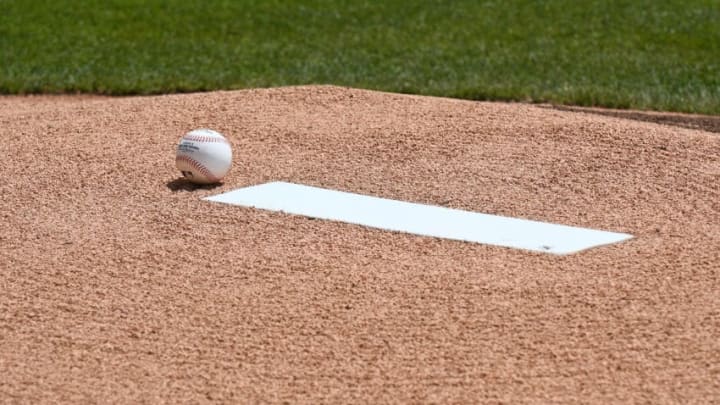One of the great pitchers from the early days of baseball history, Tommy Bond had a career that may have been worthy of the Hall of Fame.
In the early days of baseball history, pitchers tended to struggle. There were limitations to where a pitch could be placed, and pitchers threw with an underhanded motion. The idea of the game was to put the ball into play, and offenses ruled the day. Tommy Bond was one of the first pitchres to change that.
Born on this day in in 1856 in Granard, Ireland, Bond reached the majors as an 18 year old in 1874, pitching for the Brooklyn Atlantics in the National Association. He posted a solid 2.03 ERA and a 1.235 WHiP in his 497 innings that year, but only posted a 22-32 record. Bond was undone by his defense that year, as only 112 of the 440 runs he allowed were earned. However, he showed tremendous promise and incredible command, with only eight walks while striking out 42 batters.
That promise led to his moving on to the Hartford Dark Blues, where he began to emerge as a pitching star. He posted a 1.41 ERA and a 0.878 WHiP, striking out 70 batters and allowing only seven walks in his 352 innings. However, he was only 19-16, better than his rookie season, but not quite what his stats would have indicated.
More from Call to the Pen
- Philadelphia Phillies, ready for a stretch run, bomb St. Louis Cardinals
- Philadelphia Phillies: The 4 players on the franchise’s Mount Rushmore
- Boston Red Sox fans should be upset over Mookie Betts’ comment
- Analyzing the Boston Red Sox trade for Dave Henderson and Spike Owen
- 2023 MLB postseason likely to have a strange look without Yankees, Red Sox, Cardinals
Bond’s star rose in 1876, when the Dark Blues joined the newly formed National League. He won 31 games that year, posting a 1.68 ERA and a 0.902 WHiP. He completed each of his 45 starts, with just 13 walks and 88 strikeouts in his 408 innings of work. That was just the beginning.
He moved on to the Red Stockings in 1877, the predecessor to the Braves franchise. There, Bond began an incredible three year run. He won 40 or more games in each of those three seasons, posting an impressive 123-55 record. Over his 1609 innings, Bond posted a 2.04 ERA, leading the league twice, along with a 1.080 WHiP. He struck out 507 batters, while issuing only 93 walks. Bond led the league in strikeouts twice, and in shutouts in each of those three seasons, and won the pitching Triple Crown in 1877. He was, without a doubt, the top pitcher in the league during that time.
While he was dominant over those three seasons, that usage caught up to Bond. In 1880, he was not quite the same pitcher, posting a 26-29 record with a 2.67 ERA and a 1.225 WHiP. While that ERA may seem good, it was below average, worth an ERA+ of 84 for that season. He still struck out 118 batters in his 493 innings, but issued a career high 45 walks. He was still decent, but not that ace he had once been.
Over the following two years, Bond barely played. He made just five appearances on the mound, with a 0-4 record. Bond had a high 4.30 ERA and a 1.619 WHiP, allowing 52 hits and nine walks in his 37.2 innings. He played eight games in the outfield for the Worcester Ruby Legs in 1882, but produced a meager .133/.188/.133 batting line. Although he was just 26 years old, his career appeared to be over.

Atlanta Braves
Bond came back for one last year in 1884. With two new leagues coming around to challenge the National League, those teams were in need of pitchers. He started the year with the Boston Reds of the Union Association, splitting his time between the mound and third base. Bond posted a respectable .296/.313/.346 batting line, hitting eight doubles, and even refound himself on the mound. he was 13-9 with a 3.00 ERA and a 1.053 WHiP, striking out 128 batters with only 14 walks in his 189 innings.
Unfortunately, those positives did not last. Bond moved over to the Indianapolis Hoosiers of the Union Association, where he began to struggle once more. He was 0-5 in his five starts, with a 5.65 ERA and a 1.535 WHiP. Bond struck out 15 batters in his 43 innings, but allowed 62 hits and 51 runs, 24 of which were unearned.
That would prove to be his final appearance in the majors. Bond ended his ten year career with a 234-163 record, posting a 2.14 ERA and a 1.091 WHiP. He was one of the better strikeout pitchers of his time, with 972 strikeouts in his 3628.2 innings. Bond also had incredible command, with only 193 career walks. His 5.04 strikeout to walk rate is the second best in baseball history of any pitcher with over 1000 innings.
Following his playing days, Bond briefly spent time as an umpire, before moving away from the game. He worked in the Boston assessor’s office for 35 years before retiring. When he passed away in 1941 at 84 years old, he was the final surviving player from the inaugural season of the National League.
Next: Babe Ruth could have had another legacy
The first player born in Ireland in major league history, and one of the early pitching stars of the National League, Tommy Bond was one of the great players of the 1870s. Had his arm not burned out, he may well have found himself in the Hall of Fame.
